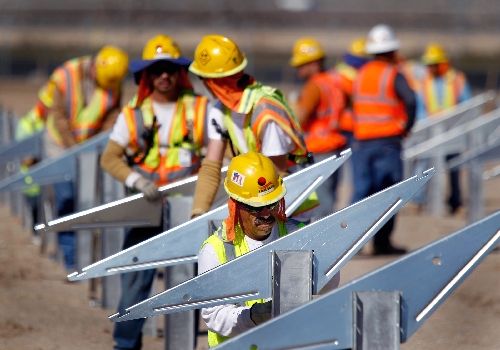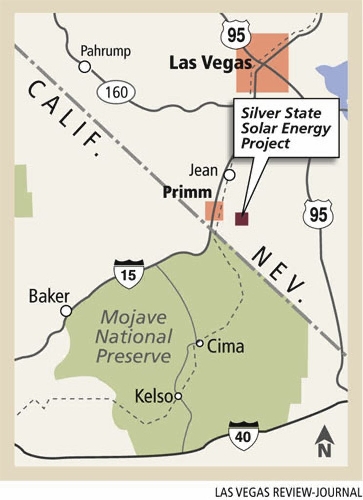Renewable energy’s job-generating power touted at Ivanpah Valley site
PRIMM -- Secretary of Interior Ken Salazar stopped in Nevada on Tuesday to tout the job-generating power of renewable energy development, but it was a little hard to hear him over the sound of the solar plant being built all around him.
The Silver State North Project in the Ivanpah Valley, not far from where Interstate 15 crosses into California, is the first solar energy facility approved for construction on federal land in Nevada. It also is the first utility-scale photovoltaic solar project to be built on public land anywhere in the United States.
"It's a very proud day for Nevada and a very proud day for the United States of America," Salazar said.
When finished later this year, the roughly 600-acre array will be able to convert light from the sun into 50 megawatts of electricity, enough to power about 15,000 homes -- at least until sundown.
NV Energy will buy the electricity, most likely for use in the Las Vegas Valley.
BENEFITING NEVADA
"That's what's so exciting," First Solar Vice President James Woodruff said. "It's a Nevada project, with Nevada workers producing energy for Nevada."
The state's largest utility company has committed to using renewable sources for 15 percent of the electricity it delivers. About 5 percent of that 15 percent will come from solar.
It's a small piece of the overall picture right now, but the use of solar energy is likely to grow as technology improves and costs decrease, NV Energy CEO Michael Yackira said.
Silver State North's 50 megawatts amounts to about 1 percent of NV Energy's total generating capacity in Southern Nevada.
Dressed in blue jeans, cowboy boots and a green National Park Service ball cap, Salazar met with some of the construction workers and helped bolt together a steel frame that will hold some of the array's roughly 820,000 solar collectors.
He said a good deal more public land could be made available in the future for renewable energy development in Nevada and across the West.
"It's almost limitless the amount of renewable energy that can power the American economy," Salazar said.
Silver State North has created about 250 construction jobs, but fewer than 10 people will be needed to operate and maintain the array once it is finished.
Woodruff expects that to happen in December.
After that, the workers may be able to catch on with other solar projects now under way or about to be started. They include new arrays planned near Boulder City and Tonopah and in the California desert.
The beginnings of one such plant, a thermal energy facility with the ability to store power for use at night, can be seen from the Silver State North site. That massive project, just across the border from Nevada, is expected to supply Southern California with about 400 megawatts of electricity.
'SUCCESS STORY'
Rob Mrowka jokingly described himself as the "token environmentalist" at Tuesday's event.
Mrowka is public lands conservation advocate for the Center for Biological Diversity.
He described Silver State North as a "success story" forged by First Solar's willingness to reach out to the environmental community. The company agreed to move the solar array into an area less likely to be used by endangered desert tortoises, Mrowka said.
As a result, only seven tortoises had to be relocated when the site was fenced.
"It breaks my heart to see the tortoise habitat destroyed. But that's part of the trade-off to deal with global climate change," Mrowka said.
Everyone who attended Tuesday's event had to undergo a few minutes of tortoise training, namely, what to do to keep from harming any of the federally protected reptiles.
Plans are already in the works for Silver State South, a 350-megawatt photovoltaic facility that would surround the current array on about 2,000 acres.
Woodruff said First Solar hopes to complete the permitting process for the much-larger second phase by the end of next year. Southern California Edison has committed to buying about 250 megawatts from Silver State South once it goes on line.
The Bureau of Land Management will hold public scoping meetings on the proposed array next Tuesday at the Primm Valley Golf Club, south of the state line; Sept. 28 at Courtyard Marriott, 5845 Dean Martin Drive, in Las Vegas; and Sept. 29 at the airport in Jean.
Each meeting is slated to run from 6 to 8 p.m.
Mrowka said he and other conservationists are already in discussions with First Solar about the expansion plans. "That's going to be more problematic," he said.
As more projects like this continue to spring up across the West, conservation groups will find themselves in the increasingly awkward position of opposing something they otherwise support: clean-energy development.
But Mrowka insists his organization and environmentalists in general aren't trying to stand in the way of progress. They simply are "pushing for proper siting," he said.
Based on his experience with First Solar, Mrowka said that push needn't escalate to all-out war.
Contact reporter Henry Brean at hbrean@reviewjournal.com or 702-383-0350.
























